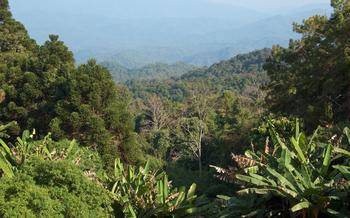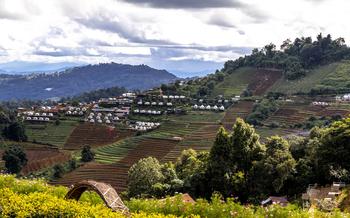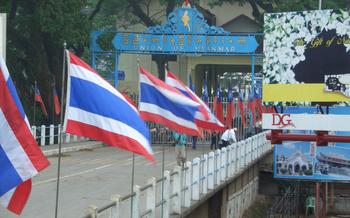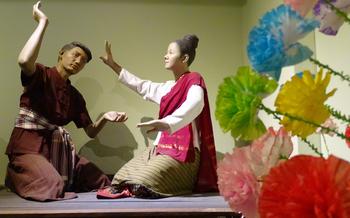
Doi Pui Tribal Village and National Park
- Doi Suthep-Pui National Park: A Haven of Natural Wonders
- Doi Pui Tribal Village: A Glimpse into Hill Tribe Culture
- Exploring the Village: A Journey Through Time
- Meeting the Villagers: Warm Smiles and Friendly Encounters
- Shopping for Unique Souvenirs: A Treasure Trove of Handicrafts
- The Hmong Village: A Unique Cultural Experience
- Trekking in the National Park: A Path to Natural Wonders
- Doi Pui Summit: A Panoramic Vista
- The Royal Project: A Legacy of Sustainable Development
- Bhubing Palace: A Royal Retreat
- Getting There: A Journey into the Mountains
- Planning Your Visit: Essential Tips
- Insider Tip: The Secret Waterfall
Doi Suthep-Pui National Park: A Haven of Natural Wonders
Nestled just outside the vibrant city of Chiang Mai, Doi Suthep-Pui National Park beckons with its breathtaking scenery, diverse wildlife, and rich cultural heritage. Designated as a UNESCO World Heritage Site, the park is a sanctuary of natural wonders, offering a serene escape from the bustling city. Ascend the winding roads and be greeted by a tapestry of lush greenery, cascading waterfalls, and panoramic vistas that stretch as far as the eye can see.
Doi Suthep-Pui National Park holds immense cultural significance for Thai Buddhists. The park is home to Wat Phra That Doi Suthep, a revered Buddhist temple perched atop Doi Suthep mountain. This sacred site attracts countless pilgrims and visitors who come to pay homage to the temple's golden chedi and seek blessings.
The park's diverse ecosystem supports a rich array of flora and fauna. Observe the graceful gibbons swinging through the trees, spot the elusive serow grazing on the slopes, and listen to the melodious songs of over 300 bird species. The park's trails wind through dense forests, leading to hidden waterfalls, serene ponds, and breathtaking viewpoints.
Doi Pui Tribal Village: A Glimpse into Hill Tribe Culture
Nestled amidst the verdant slopes of Doi Pui National Park, the Doi Pui Tribal Village stands as a living testament to the rich cultural heritage of Thailand's hill tribes. This captivating village offers visitors a unique opportunity to immerse themselves in the traditions and way of life of several ethnic groups, including the Hmong, Karen, Lisu, and Akha peoples.
As you step into the village, you are greeted by a kaleidoscope of colors and sounds, where traditional costumes, intricate handicrafts, and lively performances create a vibrant atmosphere. The village's unique architecture, featuring bamboo houses adorned with colorful decorations, reflects the deep connection between the hill tribes and their natural surroundings.
The Doi Pui Tribal Village serves as a vital source of income for the local hill tribes, who showcase and sell their handmade crafts to visitors. From intricately woven textiles and silver jewelry to carved wooden figurines and bamboo products, each item tells a story of cultural identity and craftsmanship. By supporting the artisans and purchasing their products, visitors can directly contribute to the preservation and sustainability of these age-old traditions.
However, the hill tribes face significant challenges in balancing their cultural heritage with the demands of modern society. The encroachment of tourism, deforestation, and climate change pose threats to their traditional way of life. Sustainable tourism practices are crucial to ensure that the village's cultural integrity and natural beauty are preserved for generations to come. By choosing responsible tour operators, respecting local customs, and minimizing environmental impact, visitors can contribute to the sustainable development of the Doi Pui Tribal Village.
Exploring the Village: A Journey Through Time
Doi Pui Tribal Village is a living museum that offers a glimpse into the past and the diverse cultures of the hill tribes. Founded in the early 20th century, the village is home to several tribes, including the Hmong, Karen, Akha, and Lahu, each with its own unique traditions, language, and customs.
The village is laid out around a central square, where visitors can find shops, restaurants, and cultural performances. The main attraction is the temple, which is adorned with intricate carvings and colorful murals depicting scenes from Buddhist mythology. Traditional houses surround the temple and main square, each with its own unique design and construction methods.
Visitors to the village can participate in various cultural performances and demonstrations, such as traditional dances, music, and handicrafts workshops. These performances provide a unique opportunity to learn about the rich cultural heritage of the hill tribes and their way of life. It is essential to remember to be respectful of local customs and traditions while visiting the village. Visitors should dress modestly and avoid taking photographs of people without their permission.
Meeting the Villagers: Warm Smiles and Friendly Encounters
As you stroll through the village, you'll be greeted by the warm smiles and friendly faces of the villagers. They are eager to share their culture and traditions with visitors, and they welcome the opportunity to interact with people from different parts of the world. Many of the villagers speak English, so you can easily communicate with them and learn about their lives.
There are several ways to interact with the villagers. You can join a cooking class and learn how to prepare traditional hill tribe dishes, or you can take a guided tour of the village and learn about its history and customs. You can also simply sit down with the villagers and chat with them about their lives. They are always happy to share their stories and experiences.
It's important to be respectful and mindful when interacting with the villagers. Remember that they are sharing their culture with you, and it's important to treat them with respect. Be sure to ask permission before taking photos, and avoid touching or handling any of their belongings without asking.
One of the most memorable things about visiting Doi Pui Tribal Village is the opportunity to meet the villagers and learn about their culture. They are a warm and welcoming people, and they are eager to share their lives with visitors.
Shopping for Unique Souvenirs: A Treasure Trove of Handicrafts
The Doi Pui Tribal Village is renowned for its vibrant market, a treasure trove of handmade crafts that offer a glimpse into the rich cultural heritage of the hill tribes. From intricate textiles and shimmering jewelry to finely carved wooden sculptures and delicate bamboo products, the market is a shopper's paradise.
The textiles, handwoven by skilled artisans, showcase a mesmerizing array of colors and patterns, each representing a unique tribe and its traditions. Visitors can find everything from traditional skirts and blouses to colorful shawls and cushion covers, all adorned with intricate embroidery and beadwork.
The jewelry, crafted with precision and flair, features an array of precious metals, gemstones, and intricate designs. From delicate silver earrings and necklaces to bold statement pieces, the jewelry on display is a testament to the creativity and skill of the hill tribe artisans.
Wood carvings, meticulously crafted from local woods, depict scenes from tribal life, mythical creatures, and everyday objects. Each piece is a unique work of art, showcasing the artisans' mastery of their craft.
Bamboo products, both functional and decorative, add a touch of rustic charm to any home. From intricate baskets and mats to finely carved utensils, the bamboo crafts on display are both beautiful and sustainable.
Shopping at the Doi Pui Tribal Village market is not just about acquiring souvenirs; it's about supporting the local hill tribes and preserving their cultural heritage. By purchasing these handmade crafts, visitors contribute directly to the livelihoods of the artisans and help ensure that these traditions continue to thrive.
The Hmong Village: A Unique Cultural Experience
In the heart of Doi Pui National Park lies a hidden gem—the Hmong village. Home to the Hmong people, an ethnic minority group with a rich cultural heritage, the village offers a unique glimpse into their traditional way of life.
The village is a visual feast, with colorful Hmong houses lining the narrow streets. Each house is adorned with intricate designs and vibrant colors, reflecting the Hmong people's deep connection to nature and art. The villagers are known for their skilled craftsmanship, and visitors can purchase handmade textiles, jewelry, and other souvenirs directly from the artisans.
Beyond the vibrant colors and stunning scenery, the Hmong village is a place of cultural immersion. Visitors can witness traditional dances and music performances, showcasing the Hmong people's rich artistic traditions. Villagers are eager to share their culture and way of life with visitors, making it an unforgettable and enriching experience.
However, it is important to remember that the Hmong people have a unique culture and traditions that should be respected. Visitors should dress modestly and avoid taking photos without permission. By being mindful and respectful, visitors can help preserve the authenticity and integrity of the Hmong village and its people.
Trekking in the National Park: A Path to Natural Wonders
Within the embrace of Doi Suthep-Pui National Park, a network of trekking trails unfolds, inviting adventurers to delve into the heart of nature's wonders. Whether seeking the thunderous cascade of waterfalls, the panoramic vistas from lofty viewpoints, or the whisper of ancient ruins, the park's trails offer a path to profound encounters.
For those seeking a gentle introduction, the trail to Mon Tha Than Waterfall beckons. Along its well-trodden path, the soothing melody of cascading waters guides trekkers to a hidden gem, where nature's artistry paints a breathtaking spectacle.
Venturing further into the park's embrace, the trek to Doi Pui Summit presents a more challenging ascent. Through lush forests and verdant slopes, the trail leads to the park's highest peak, where panoramic vistas unfold, stretching from the patchwork of rice paddies to the distant horizon.
For those captivated by the allure of history, the trail to the ruins of an ancient city beckons. Amidst the verdant tapestry of the jungle, remnants of a forgotten civilization emerge, whispering tales of a bygone era.
To fully immerse in the park's natural wonders and cultural heritage, consider enlisting the services of a knowledgeable local guide. Their expertise ensures a safe and enriching experience, unlocking the secrets of the park's flora, fauna, and fascinating history.
Before embarking on your trekking adventure, remember to pack essentials such as sturdy footwear, ample water, insect repellent, and a sense of wonder. The journey through Doi Suthep-Pui National Park promises to be a transformative experience, etching indelible memories in the tapestry of your soul.
Doi Pui Summit: A Panoramic Vista
Doi Pui, the highest peak in Doi Suthep-Pui National Park, beckons adventurers with its promise of breathtaking panoramic vistas. As you ascend the mountain, the lush greenery gives way to stunning views of the surrounding landscape. The climb is challenging, but the reward is immeasurable.
Upon reaching the summit, you'll be greeted by a breathtaking 360-degree panorama that will leave you speechless. The rolling hills, sprawling valleys, and distant mountain ranges stretch out before you like a living painting. The sense of accomplishment and awe is palpable as you take in the sheer beauty of nature's masterpiece.
Before embarking on this challenging trek, ensure you're well-prepared. Wear comfortable hiking shoes, bring plenty of water and snacks, and don't forget your camera to capture the unforgettable moments. Hiring a local guide is highly recommended, as they can lead you safely to the summit and share insights into the park's natural and cultural history.
The Doi Pui summit is not just a destination; it's an experience that will stay with you long after your visit. Whether you're a seasoned hiker or a nature enthusiast, the panoramic vista from Doi Pui is sure to leave an indelible mark on your soul.
The Royal Project: A Legacy of Sustainable Development
In the heart of Doi Suthep-Pui National Park, the Royal Project stands as a beacon of sustainable development, a legacy of the late King Bhumibol Adulyadej's vision to improve the livelihoods of hill tribe communities while preserving the environment. Founded in 1969, the project has transformed the lives of these marginalized communities by introducing sustainable agricultural practices, promoting alternative crops, and providing education and healthcare.
Through the Royal Project, hill tribe farmers have transitioned from opium cultivation to growing temperate fruits, vegetables, and flowers, ensuring a stable income while protecting the environment. The project's holistic approach extends beyond agriculture, encompassing reforestation efforts, watershed management, and community development initiatives.
The success of the Royal Project is evident in the thriving hill tribe communities, the reduced deforestation rates, and the improved quality of life for the people living in the national park. Visitors to Doi Pui Tribal Village can witness firsthand the positive impact of the project, as the villagers showcase their agricultural products and share their stories of transformation.
Supporting the Royal Project is not just about purchasing their high-quality produce; it's about contributing to a sustainable future for these communities and the environment. By choosing products that bear the Royal Project logo, travelers can play a part in this remarkable legacy of sustainable development, ensuring that the beauty and diversity of Doi Suthep-Pui National Park are preserved for generations to come.
Bhubing Palace: A Royal Retreat
Nestled amidst the lush greenery of Doi Suthep-Pui National Park lies Bhubing Palace, a former royal summer palace that exudes an aura of tranquility and grandeur. Built in 1961 by the late King Bhumibol Adulyadej, the palace served as a serene retreat for the Thai royal family, offering respite from the bustling city life.
With its beautiful gardens adorned with colorful flowers and manicured lawns, Bhubing Palace is a sight to behold. The palace's architecture is a blend of traditional Thai and Swiss styles, reflecting the king's love for both cultures. Visitors can admire the intricate carvings, ornate gables, and graceful spires that adorn the palace's facade.
Bhubing Palace holds historical significance as it played a crucial role in the Thai royal family's history. It was here that King Bhumibol Adulyadej spent his childhood summers, fostering a deep connection with nature and the local hill tribes. The palace also served as a venue for important events and royal functions, hosting distinguished guests from around the world.
Today, Bhubing Palace is open to the public, offering visitors a glimpse into the life and legacy of the Thai royal family. Visitors can wander through the palace's well-maintained gardens, admire the exquisite architecture, and learn about its fascinating history. The palace also features a museum that showcases artifacts, photographs, and documents related to the royal family's stay at Bhubing.
Exploring Bhubing Palace is a unique and enriching experience that allows visitors to delve into the history and culture of Thailand's royal family. Whether you're a history buff, an architecture enthusiast, or simply seeking a tranquil escape, Bhubing Palace is a must-visit destination in Doi Suthep-Pui National Park.
Getting There: A Journey into the Mountains
Reaching Doi Pui Tribal Village and National Park from Chiang Mai is an adventure in itself, taking you through winding mountain roads and lush landscapes. To make the most of your journey, consider the following options:
-
Public Transportation: Hop on a local bus from Chiang Mai's Arcade Bus Station to Mae Rim, then transfer to a songthaew (shared taxi) to Doi Suthep Temple. From there, you can hike or take a motorbike taxi to the village.
-
Taxi: Taxis are readily available in Chiang Mai and can be hired for a day trip to Doi Pui. Negotiate a price before departure, and ensure the driver is familiar with the route.
-
Private Tour: Opt for a private tour if you prefer a hassle-free experience. Tours typically include transportation, a local guide, and other activities such as trekking or visiting local markets.
-
Rental Car or Motorbike: For the adventurous, renting a car or motorbike offers the freedom to explore the area at your own pace. However, ensure you have a valid driving license and are comfortable navigating mountain roads.
Whichever option you choose, remember to plan ahead, especially during peak tourist season. Advance booking for transportation and tours is recommended to avoid disappointment.
Planning Your Visit: Essential Tips
To fully enjoy your visit to Doi Pui Tribal Village and National Park, careful planning is essential. The best time to visit is during the cool season from November to February when the weather is pleasant for trekking and exploring the village. It's advisable to book your transportation and tour operator in advance, especially during peak season.
When packing for your trip, comfortable shoes are a must, as the village and park involve a lot of walking. Sunscreen and insect repellent will protect you from the sun and pesky insects. Remember to dress respectfully when visiting the temple and village, covering your shoulders and knees.
Respecting local customs and traditions is paramount. Ask permission before taking photos of people or sacred sites, and avoid touching religious objects or making loud noises. With these tips in mind, you're sure to have a memorable and enriching experience in Doi Pui Tribal Village and National Park.
Insider Tip: The Secret Waterfall
Hidden deep within the lush forests of Doi Suthep-Pui National Park lies a secret waterfall, a hidden gem waiting to be discovered. This secluded paradise, known only to a few locals and adventurous travelers, offers a tranquil escape from the bustling crowds of Chiang Mai.
To reach the secret waterfall, follow the trail that leads from the Hmong village, immersing yourself in the beauty of the surrounding nature. As you venture deeper into the forest, the sounds of the city fade away, replaced by the gentle chirping of birds and the rustling of leaves.
After a short hike, you will be rewarded with the sight of the waterfall, cascading down from a rocky cliff into a crystal-clear pool. The water, shimmering in the sunlight, invites you to take a refreshing dip and immerse yourself in the tranquility of this hidden oasis.
As you relax by the waterfall, take a moment to appreciate the beauty of your surroundings. The lush vegetation, the cascading water, and the fresh air create a serene atmosphere that will leave you feeling rejuvenated and refreshed.
Remember to respect the natural environment and leave no trace of your visit. Pack out all your trash, avoid using harsh chemicals, and be mindful of the wildlife. By doing so, you can help preserve this hidden gem for future generations to enjoy.









